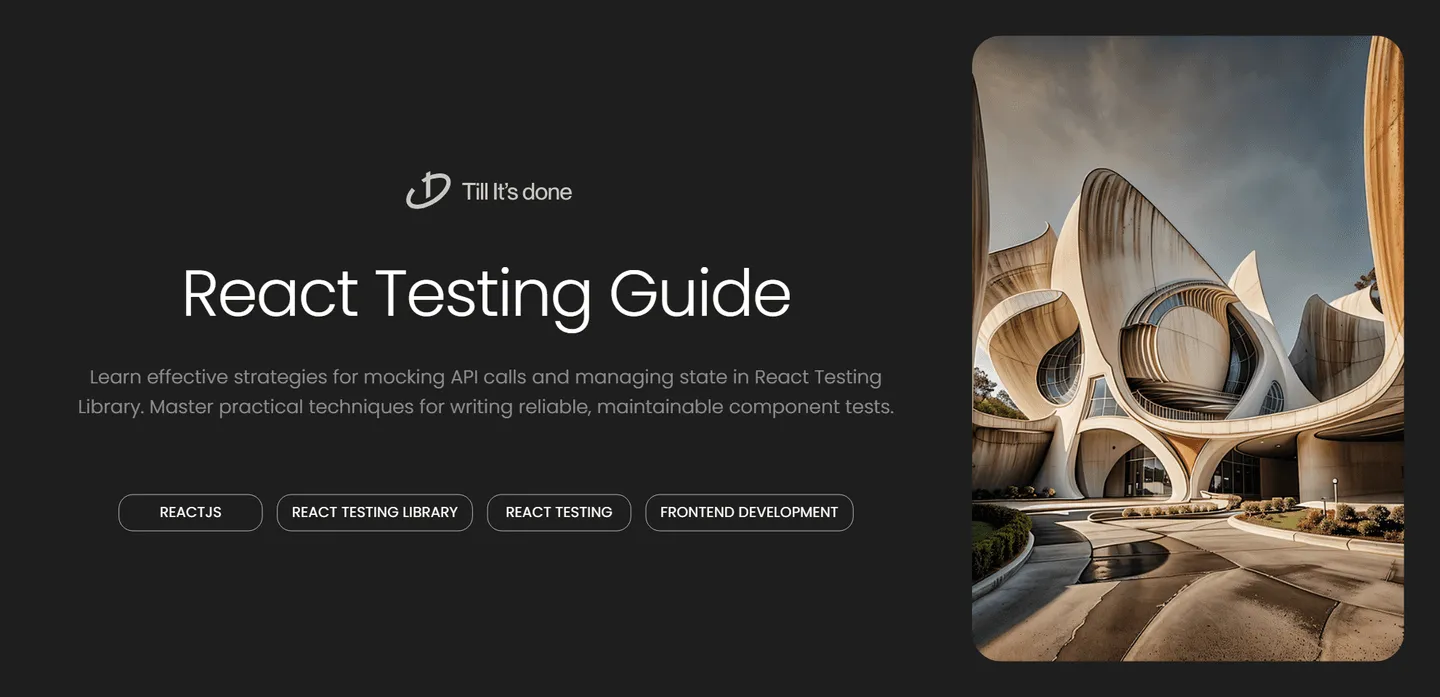- Services
- Case Studies
- Technologies
- NextJs development
- Flutter development
- NodeJs development
- ReactJs development
- About
- Contact
- Tools
- Blogs
- FAQ
Mocking APIs & State in React Testing Library
Master practical techniques for writing reliable, maintainable component tests.

Mocking APIs and State Management in React Testing Library

Testing modern React applications can be challenging, especially when dealing with complex API calls and state management. Today, let’s dive into practical strategies for mocking APIs and testing state management using React Testing Library.
Understanding API Mocking
When testing components that make API calls, we don’t want to hit real endpoints. This would make our tests slow, unreliable, and dependent on external services. Instead, we use mocking to simulate API responses.

The most common approach is to use Jest’s mocking capabilities along with MSW (Mock Service Worker). MSW lets us intercept network requests and provide mock responses, making our tests more predictable and maintainable.
Setting Up MSW
First, let’s set up MSW in our testing environment. We’ll create handlers that intercept our API calls and return mock data:
import { rest } from 'msw';import { setupServer } from 'msw/node';
const server = setupServer( rest.get('/api/users', (req, res, ctx) => { return res( ctx.json([ { id: 1, name: 'John' }, { id: 2, name: 'Sarah' } ]) ); }));
beforeAll(() => server.listen());afterEach(() => server.resetHandlers());afterAll(() => server.close());Testing State Management
When it comes to state management, whether you’re using Redux, Context API, or other solutions, React Testing Library encourages testing from the user’s perspective.

Here’s a practical example of testing a component that fetches data and updates state:
test('displays user data after fetching', async () => { render(<UserList />);
// Wait for loading state expect(screen.getByText('Loading...')).toBeInTheDocument();
// Wait for user data const users = await screen.findAllByRole('listitem'); expect(users).toHaveLength(2); expect(users[0]).toHaveTextContent('John');});Best Practices
- Always test loading states
- Handle error scenarios
- Test state transitions
- Verify user interactions
- Keep tests focused and isolated
Remember, the goal is to test behavior, not implementation. Focus on what users see and interact with, rather than internal state mechanics.
Advanced Scenarios
Sometimes you’ll need to test more complex scenarios, like error handling or race conditions. MSW makes this straightforward:
test('handles API errors gracefully', async () => { server.use( rest.get('/api/users', (req, res, ctx) => { return res(ctx.status(500)); }) );
render(<UserList />);
const errorMessage = await screen.findByText(/error fetching users/i); expect(errorMessage).toBeInTheDocument();});
By following these patterns and principles, you’ll create more reliable and maintainable tests that give you confidence in your application’s behavior. Remember, good tests should be easy to write, easy to read, and provide value through catching real issues.
 สร้างเว็บไซต์ 1 เว็บ ต้องใช้งบเท่าไหร่? เจาะลึกทุกองค์ประกอบ website development cost อยากสร้างเว็บไซต์แต่ไม่มั่นใจในเรื่องของงบประมาณ อ่านสรุปเจาะลึกตั้งแต่ดีไซน์, ฟังก์ชัน และการดูแล พร้อมตัวอย่างงบจริงจาก Till it’s done ที่แผนชัด งบไม่บานปลายแน่นอน
สร้างเว็บไซต์ 1 เว็บ ต้องใช้งบเท่าไหร่? เจาะลึกทุกองค์ประกอบ website development cost อยากสร้างเว็บไซต์แต่ไม่มั่นใจในเรื่องของงบประมาณ อ่านสรุปเจาะลึกตั้งแต่ดีไซน์, ฟังก์ชัน และการดูแล พร้อมตัวอย่างงบจริงจาก Till it’s done ที่แผนชัด งบไม่บานปลายแน่นอน  Next.js สอน 14 ขั้นตอนเบื้องต้น: สร้างโปรเจกต์แรกใน 30 นาที เริ่มต้นกับ Next.js ใน 14 ขั้นตอนเพียงแค่ 30 นาที พร้อม SSR/SSG และ API Routes ด้วยตัวอย่างโค้ดง่าย ๆ อ่านต่อเพื่อสร้างโปรเจ็กต์แรกได้ทันทีที่นี่
Next.js สอน 14 ขั้นตอนเบื้องต้น: สร้างโปรเจกต์แรกใน 30 นาที เริ่มต้นกับ Next.js ใน 14 ขั้นตอนเพียงแค่ 30 นาที พร้อม SSR/SSG และ API Routes ด้วยตัวอย่างโค้ดง่าย ๆ อ่านต่อเพื่อสร้างโปรเจ็กต์แรกได้ทันทีที่นี่  วิธีสมัคร Apple Developer Account เพื่อนำแอปขึ้น App Store ทีละขั้นตอน อยากปล่อยแอปบน App Store ระดับโลก มาอ่านคู่มือสมัคร Apple Developer Account พร้อมเคล็ดลับ TestFlight และวิธีอัปโหลดที่ง่ายในบทความเดียวนี้ได้เลย
วิธีสมัคร Apple Developer Account เพื่อนำแอปขึ้น App Store ทีละขั้นตอน อยากปล่อยแอปบน App Store ระดับโลก มาอ่านคู่มือสมัคร Apple Developer Account พร้อมเคล็ดลับ TestFlight และวิธีอัปโหลดที่ง่ายในบทความเดียวนี้ได้เลย  TypeScript Interface คืออะไร? อธิบายพร้อมวิธีใช้และข้อแตกต่างจาก Type เรียนรู้วิธีใช้ TypeScript Interface เพื่อสร้างโครงสร้างข้อมูลที่ปลอดภัยและเข้าใจง่าย พร้อมเปรียบเทียบข้อดีข้อแตกต่างกับ Type ที่คุณต้องรู้ ถูกรวมเอาไว้ในบทความนี้แล้ว
TypeScript Interface คืออะไร? อธิบายพร้อมวิธีใช้และข้อแตกต่างจาก Type เรียนรู้วิธีใช้ TypeScript Interface เพื่อสร้างโครงสร้างข้อมูลที่ปลอดภัยและเข้าใจง่าย พร้อมเปรียบเทียบข้อดีข้อแตกต่างกับ Type ที่คุณต้องรู้ ถูกรวมเอาไว้ในบทความนี้แล้ว  Material-UI (MUI) คืออะไร อยากสร้าง UI สวยงามและเป็นมืออาชีพในเวลาอันรวดเร็วใช่ไหม มาทำความรู้จักกับ Material-UI (MUI) ที่ช่วยให้คุณพัฒนาแอปพลิเคชันบน React ได้ง่ายและดูดีในทุกอุปกรณ์
Material-UI (MUI) คืออะไร อยากสร้าง UI สวยงามและเป็นมืออาชีพในเวลาอันรวดเร็วใช่ไหม มาทำความรู้จักกับ Material-UI (MUI) ที่ช่วยให้คุณพัฒนาแอปพลิเคชันบน React ได้ง่ายและดูดีในทุกอุปกรณ์  เปรียบเทียบ 3 วิธีติดตั้ง install node js บน Ubuntu: NVM vs NodeSource vs Official Repo แบบไหนดีที่สุด? เรียนรู้วิธีติดตั้ง Node.js บน Ubuntu ด้วย NVM, NodeSource หรือ Official Repo เลือกวิธีที่เหมาะกับความต้องการของคุณ พร้อมเปรียบเทียบ เพื่อการพัฒนาที่มีประสิทธิภาพ!
เปรียบเทียบ 3 วิธีติดตั้ง install node js บน Ubuntu: NVM vs NodeSource vs Official Repo แบบไหนดีที่สุด? เรียนรู้วิธีติดตั้ง Node.js บน Ubuntu ด้วย NVM, NodeSource หรือ Official Repo เลือกวิธีที่เหมาะกับความต้องการของคุณ พร้อมเปรียบเทียบ เพื่อการพัฒนาที่มีประสิทธิภาพ! Talk with CEO
We'll be right here with you every step of the way.
We'll be here, prepared to commence this promising collaboration.
Whether you're curious about features, warranties, or shopping policies, we provide comprehensive answers to assist you.


